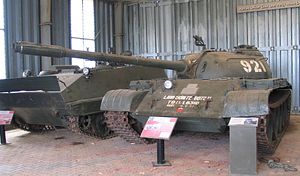In the last two decades, Hanoi has concentrated its limited resource to strengthen some of its aerial and maritime capabilities, but the rest of Vietnam’s military equipment is moving toward obsolescence due to lack of renewal. Despite lack of a universal definition, military obsolescence can be seen from two perspectives: absolute and relative. The former refers to operational readiness, and the latter signifies a comparison of capabilities between a state and its potential enemy. In Vietnam’s case, the relative perspective is more salient because of China’s comprehensive military modernization. While Hanoi’s new fighters, submarines, and frigates are not inferior to their Chinese counterparts, other Vietnamese capabilities would be vulnerabilities available for Beijing to exploit. Minesweeping, armored vehicles, and artillery are three major examples.
Minesweeping
The Vietnam People’s Army Navy (VPAN) possesses four kinds of minesweeping vessels, Project 266, Project 1258, Project 1265, and Project T-361; all are Soviet legacies from the Cold War with old countermine technology, small capacity, and short durability. Vietnam’s long coastline and large maritime territory puts a heavy burden on those minesweepers. Given that the Chinese People’s Liberation Army Navy (PLAN) is prepared to create a blockade by laying sea mines, the VPAN may not be able to keep its sea lines of communication (SLOCs) open with its limited minesweeping capacity.
Aside from the six submarines, Hanoi lacks effective means to retaliate with the same tactic to disrupt China’s SLOCs. Of course, the VAPN can attack the PLAN’s surface vessels and aircraft while laying sea mines offshore, but countering sea mines laid by submarines is a different challenge thanks to Hanoi’s limited anti-submarine capability. When options for denial and punishment are unavailable, Vietnam has to make a difficult decision between enduring the impact, submitting, or escalating he conflict; all are unpleasant.
Armored Vehicles
Back in the Cold War era, Vietnam received a lot of land systems from the Soviet Union in considerable quality and quantity. But more than a quarter of century since the end of the military aid, those assets have gradually become outdated in the face of China’s continuous military modernization.
Currently, the Vietnamese main battle tanks (MBTs) are all legacies from the front part of the Cold War, T-54/55s, T-62s, and Type 59s. In contrast, the PLA has modernized its MBT units with Type 88, Type 96, and Type 99, one or more generations ahead of the VPA’s, reflecting greater firepower, mobility, and protection. Although Hanoi introduced Israeli technologies to upgrade its T-55 MBTs, the generation gap was not fully overcome. In other words, an armor battle between China and Vietnam would favor the former.
Since MBTs are usually the spearhead for offense, this technological gap would determine the strategic situation on the Sino-Vietnamese borders. Although anti-tank missiles have demonstrated promise in various cases, the VPA’s missiles — the 9M14M and 9M111 — are also Cold War legacies, meaning their damage to the Chinese MBTs’ new armor could be uncertain. Besides, the VPA have both self-propelled and towed anti-tank guns, mainly designs from World War II, and thee should not be high expectations for their performance.
Artillery
Having benefited from later designs and technologies, Chinese artillery systems, especially self-propelled guns and multi-launch rocket systems (MLRS), have superior ranges to their Vietnamese counterparts. Longer ranges not only provide the PLA artillery more flexibility than the VPA, but also reduce the latter’s opportunity to retaliate. Although Hanoi has artillery rockets and missiles with longer ranges, such as the Israeli EXTRA and Russian R-17 (Scud), to apply them would invite stronger retaliation from Beijing’s larger arsenals of standoff munitions. If the VPA’s artillery is suppressed by that of the PLA, the former’s frontline units, including MBTs, would be in an even worse operational condition.
The demarcation of land borders through bilateral treaties between Hanoi and Beijing in the 1990s removed a common cause of armed conflict: territorial disputes. China would not want to create a negative impression through a land invasion. However, the VPA’s inferior military capability on land defense still presents an effective means for the PLA to exert strategic pressure. Exercises, forward deployments, and even exchanges of fire on a small scale would send additional messages from China. Despite higher political costs for Beijing, Hanoi is not remote from the border. The mountainous terrain between the Red River Delta and the borders would help the VPA to resist a northward invasion, but does nothing to deter artillery rockets and missiles, not to mention air raids. China thus has a spectrum of operation options on land to use against Vietnam.
These capabilities can be improved a lot with sufficient investment, but the allocation of the defense budget would be a dilemma for Hanoi. On the one hand, even with the current emphasis on air defense and sea denial, these capabilities have not reached an equivalent stage vis-à-vis their Chinese counterparts. Shifting resources to other areas may disrupt the existing projects. On the other hand, the strategic vulnerabilities mentioned above will be worse for aging, given no considerable investment.
Raising the budget may solve the dilemma but it is likely to create a larger problem in balancing between defense and other needs. Building allies to cover up the insufficiencies in Hanoi’s military capabilities would be another option, but it would work against Vietnam’s current foreign policy. Hostility toward China may be too strong to retain Hanoi’s hedging policy toward Beijing. Also, even an alliance might not give Vietnam the support it needs. As there is no easy solution, Vietnamese defense planners will be obsessed with the challenges originating from military obsolescence in the foreseeable future.
Shang-su Wu is a research fellow in the Military Studies Program of the S. Rajaratnam School of International Studies (RSIS), Nanyang Technological University.

































